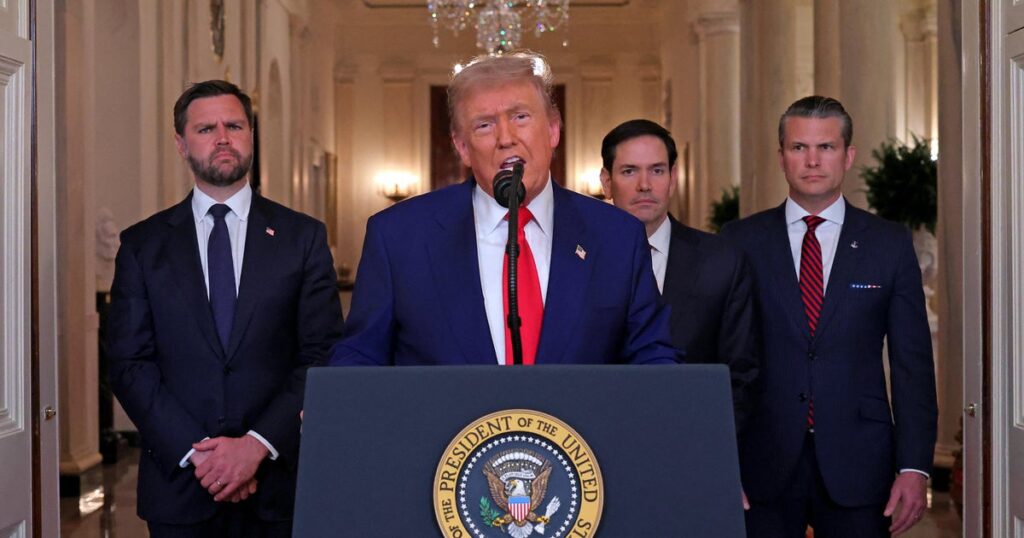Washington — President Trump addressed the nation from the White House Saturday night about the U.S. strikes on Iran.
In his remarks, the president described the strikes on Iranian nuclear sites as a “spectacular military success.” He warned of “far greater” attacks if Iran does not “make peace.”
“There will be either peace or there will be tragedy for Iran far greater than we have witnessed over the last eight days,” Mr. Trump said. “Remember, there are many targets left.”
Mr. Trump announced earlier Saturday evening on social media that the U.S. had launched strikes against three Iranian nuclear sites at Fordo, Natanz and Isfahan. He said in his address that the sites “have been completely and totally obliterated.”
The president said the objective of the strikes was to end “the nuclear threat posed by the world’s No. 1 state sponsor of terror.” Prior to the start of military action, Mr. Trump sought a deal with Iran to curtail its nuclear program.
In his televised address, the president called Saturday’s three targets “the most difficult of them all, by far, and perhaps the most lethal.” He said other sites could be targeted “with precision, speed and skill” in the future “if peace does not come quickly.”
Mr. Trump thanked U.S. service members. He also thanked the Israeli military, which began targeting sites in Iran just over a week ago, and Israeli Prime Minister Benjamin Netanyahu. The U.S. alerted Israel ahead of Saturday evening’s strikes, and Mr. Trump spoke with Netanyahu afterwards, White House officials told CBS News.
During his brief remarks, Mr. Trump was flanked by Vice President JD Vance, Secretary of State Marco Rubio and Defense Secretary Pete Hegseth.
Mr. Trump said Hegseth and Joint Chiefs Chairman Dan Caine would hold a news conference with updates on the situation Sunday morning at 8 a.m. ET.
Iran’s Atomic Energy Organization has confirmed the strikes, but said the attack would not stop Iran from advancing its nuclear program. In a statement, it called on the international community to condemn the attacks. Iran’s main state TV channels have so far been downplaying the impact of the strikes, claiming the sites had already been evacuated and denying any damage to the Fordo uranium enrichment facility.
Prior to Saturday’s airstrikes, Iran had threatened to retaliate against the U.S. if it joined the Israeli offensive. An Iranian official had warned Wednesday that U.S. intervention would risk “all-out war.” Iran has launched missiles at Israel over the last week.
In a Truth Social post following Saturday’s address, Mr. Trump said any Iranian retaliation “WILL BE MET WITH FORCE FAR GREATER THAN WHAT WAS WITNESSED TONIGHT.”
Iran’s foreign minister, Seyed Abbas Araghchi, said in a post on X that the U.S. “has committed a grave violation” of the United Nations Charter and international law,
“In accordance with the UN Charter and its provisions allowing a legitimate response in self-defense, Iran reserves all options to defend its sovereignty, interest, and people,” he said.
3 Iranian nuclear sites targeted
All three sites that were targeted Saturday evening are part of Iran’s nuclear program. Fordo is 300 feet underground and protected by a Russian-produced anti-missile system. It’s a high-grade uranium enrichment plant that can hold about 3,000 centrifuges. Fordo has long been believed by nuclear weapons experts to be central to any effort by Iran to produce weapons-grade uranium because of its size, security and technical capacity.
CBS News
Natanz, which is about 135 miles southeast of Tehran, in Isfahan province, is the country’s main enrichment site. It operates multiple cascades of centrifuges working together to more quickly enrich uranium. On June 13, Israel struck Natanz, and IAEA Director-General Rafael Mariano Grossi told the United Nations Security Council Iran had confirmed the attack on Natanz and said the above-ground portion of the plant where Iran was producing uranium enriched up to 60% was “destroyed” and centrifuges may have been damaged.
The Isfahan facility, about 80 miles south of Natanz, hosts thousands of nuclear scientists and is home to three Chinese research reactors and laboratories associated with the country’s atomic program.
President Trump posted a screenshot of a post on X from “Open Source Intel” that says: “Fordow is gone.”
The U.S. carried out the strikes nine days after Israel launched its offensive on Iranian military and nuclear targets — an operation Mr. Trump said the U.S. was not involved with.
Iran has increased its stockpile of highly enriched uranium in recent months, according to the IAEA — though Iran has long insisted its nuclear program is only intended for peaceful purposes. Before Israel’s initial strikes the IAEA noted in a classified report obtained by CBS News that Iran is the only non-nuclear weapon state in the world that is producing and accumulating uranium enriched to 60%, which remains a matter of serious concern. Uranium for civilian use is enriched to a much lower rate, between 3% and 5%.
On Friday, the president said his director of national intelligence, Tulsi Gabbard, was “wrong” when she testified in March that Iran wasn’t building a nuclear weapon, and the White House said this week that Iran has everything it needs to build a nuclear weapon and a green light from Iran’s supreme leader would enable Iran to ready a nuclear weapon within weeks. Mr. Trump said Iran was “very close to having” a nuclear weapon. Gabbard was among the White House officials in the Situation Room monitoring the U.S. strikes Saturday.
Aaron Navarro,
,
Margaret Brennan,
and
Jennifer Jacobs
contributed to this report.
https://www.cbsnews.com/news/trump-address-nation-us-iran-strike/



